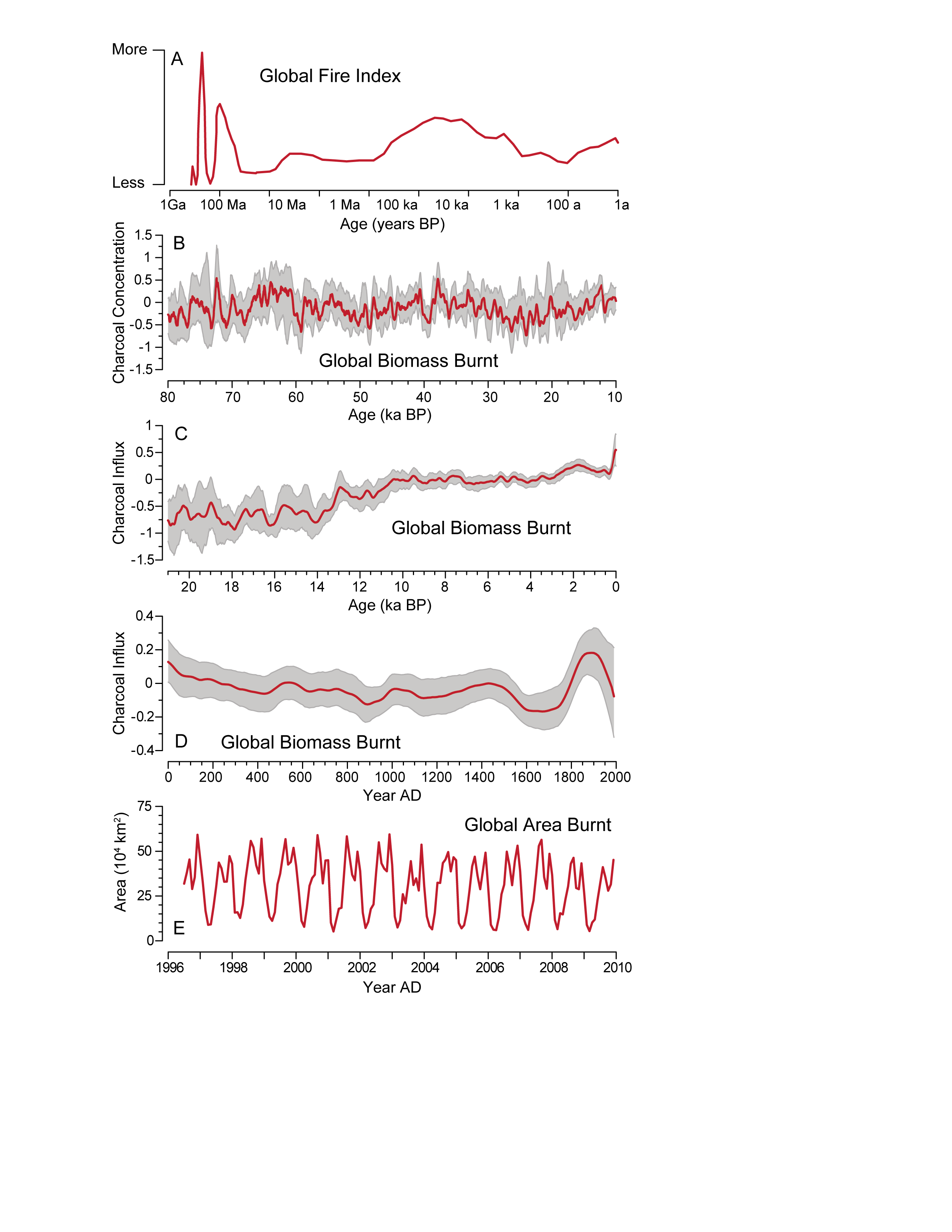- Home
- Publications
- PAGES Magazine
- Fire - Are We Facing An Increase In Wildfires? [Past]
Fire - Are we facing an increase in wildfires? [Past]
Sandy P. Harrison and Patrick J. Bartlein
PAGES news
20(1)
25
2012
Sandy P. Harrison1 and Patrick J. Bartlein2
1School of Biological Sciences, Macquarie University, North Ryde, Australia; sandy.harrison mq.edu.au
mq.edu.au
2Department of Geography, University of Oregon, Eugene, USA
Wildfire, the most widespread form of vegetation disturbance, has multiple influences on climate, and places an increasingly large socio-economic burden on society. Remote-sensing and historical records provide insights into how climatic, environmental and human factors influence the incidence of wildfire. These sources only cover the last few decades – a period when climate variations were much smaller than the changes expected during the 21st century and, globally, there were no radical changes in human activities. Luckily, there are other sources of information about changes in regional wildfire regimes in response to both large climatic changes and fundamental shifts in human activities. These sources include measurements of the isotopic composition of atmospheric gases trapped in ice cores, fire scars on living and fossil trees, and biomarkers and charcoal preserved in sediments. Of these, the most abundant are sedimentary charcoal: there are well over 800 site records worldwide, some providing high-resolution data for the last few millennia and some records spanning several glacial-interglacial cycles (Fig. 1).
Globally, fire is low during cold, glacial intervals and high during warm, interglacial intervals (Daniau et al. 2010a). The incidence of fire tracks the shift in global temperature during the last deglaciation (Power et al. 2008). It also tracks the rapid temperature changes (Dansgaard-Oeschger cycles) during the last glaciation with a lag of <50-100 years (Daniau et al. 2010a; Mooney et al. 2011). On centennial to multi-millennial time-scales and regional to global space-scales, temperature is the major driver of changes in biomass burning: increasing temperature leads to increased fire through increasing plant productivity and hence fuel production (Daniau et al., unpublished data). The effect of precipitation change is more complex. Fire peaks at intermediate precipitation levels at all temperatures: fire is low in dry environments because of lack of fuel and in wet environments because the fuel is too damp to burn. The impact of a precipitation change will depend on whether a site lies in a dry “fuel-limited” or a wet “drought-limited” environment. These climate-fire relationships are not unique to the paleorecord: similar relationships are found in global analyses of remotely sensed burnt area (Daniau et al., unpublished data).
The paleorecord shows surprisingly little evidence of human impact on regional fire regimes. Colonization of uninhabited islands, such as New Zealand, may be marked by an increase in fire, as may cultural transitions, such as the European colonization of Australia (Mooney et al. 2011). However, there are examples of both colonization and cultural transition that are not accompanied by changes in fire. The transition from Neanderthal to Modern Humans in Europe was not accompanied by a change in fire regime (Daniau et al. 2010b); similarly, changes in fire regimes in the Americas are not synchronous with the dramatic collapse of indigenous populations after European colonization (Power et al., unpublished data). The largest human impact occurred around the end of the 19th century – the expansion of industrial-scale agriculture in many parts of the world, which resulted in substantial landscape fragmentation, coincides with decreases in fire in the affected regions and a large global decrease in biomass burning (Marlon et al. 2008; Wang et al. 2010).
Direct extrapolation of paleo-evidence to predict the future would be unreliable: the past is not an analogue for future climate and environmental changes because the combination of causal factors is different and regional land-use patterns have changed radically. But paleorecords show there are predictable relationships between climate and natural fire regimes. These relationships mean we can draw lessons from the paleorecord that have implications for fire in the 21st century. The paleorecord indicates that global warming will result in a global increase in fire; this will be mitigated in some regions by precipitation changes which either reduce fuel loads (warmer and drier climates) or increase fuel moisture (monsoonal climates). Human activities resulting in continued landscape fragmentation (e.g. urbanization, tropical deforestation) could reduce the influence of climate – but mitigation measures involving afforestation may lead to an increase in wildfires.
selected references
Full reference list online under: http://pastglobalchanges.org/products/newsletters/ref2012_1.pdf
Daniau A-L, d’Errico F and Sánchez Goñi MF (2010b) PloSONE 5, doi: 10.1371/journal.pone.0009157
Marlon J et al. (2008) Nature Geoscience 1: 697-702
Mooney S et al. (2011) Quaternary Science Reviews 30: 28-46
Power MJ et al. (2008) Climate Dynamics 30: 887-907
Wang Z, Chappellaz J, Park K and Mak JE (2010) Science 330: 1663-1666
